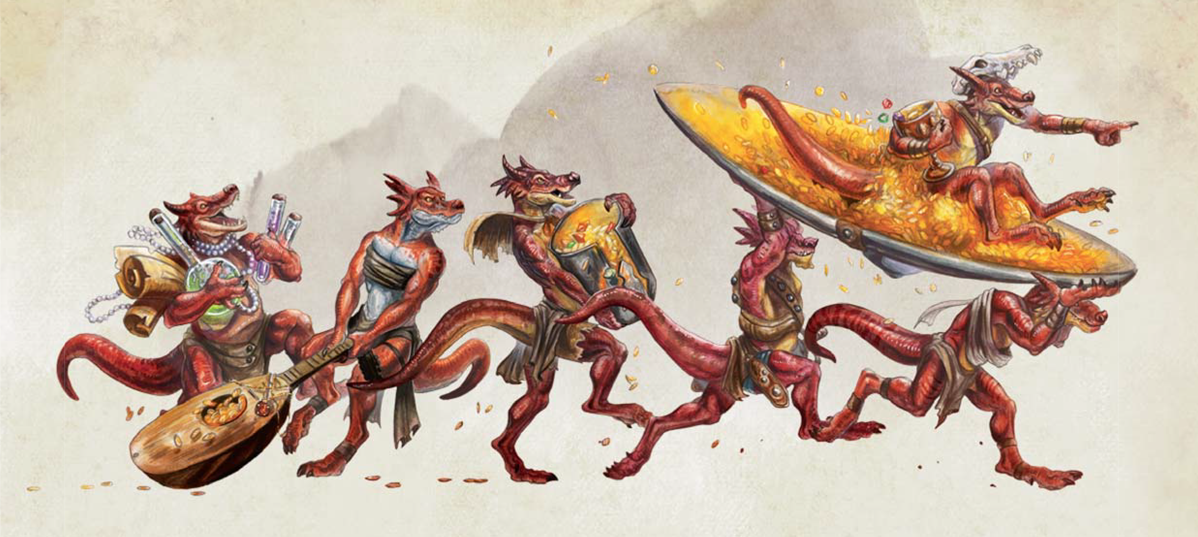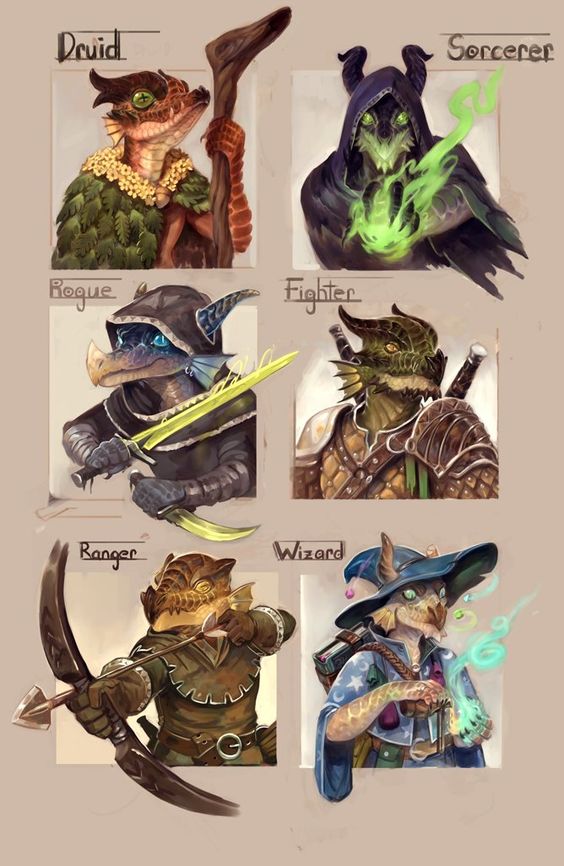Vermin Heritage
Also known as kobolds
Kobolds are (c) Wizards of the Coast.
Kobolds are often dismissed as cowardly, foolish, and weak, but these little vermin-like actually have a strong social structure that stresses devotion to the tribe, are clever with their hands, and viciously work together in order to overcome their physical limitations.
In the kobolds’ version of a perfect world, the creatures would be left alone to dig their tunnels and raise the next generation of kobolds, all the while seeking the magic that will free their imprisoned souls. In the world they occupy, kobolds are often bullied and enslaved by larger creatures — or, when they live on their own, they are constantly fearful of invasion and oppression. Although individually they are timid and shy away from conflict, kobolds are dangerous if cornered, vicious when defending their young, and notorious for the dangerous improvised traps they use to protect their warrens.
A kobold acknowledges its weakness in the face of a hostile world. It knows it is puny, bigger creatures will exploit it, it will probably die at a young age, and its life will be full of toil. Although this outlook seems bleak, a kobold finds satisfaction in its work and the survival of its tribe. A kobold doesn’t like being cornered or alone. It wants to know it has a safe path for escape, or at least an ally nearby to improve its chances. A kobold without either of these options will be nervous, its behavior alternating between meek silence and hysteria.
Basic Information
Kobolds are small with digitigrade legs. They have three taloned toes on each foot along with a vestigial dewclaw, three clawed fingers on their hands, and distended snouts that are full of sharp, needle-like teeth. Kobolds have short tails, typically no more than a foot long, and some my have keratinous horns or spines at different places. Kobolds have snakelike hides of soft, small scales.
Kobold males have an internally stored penis, and both sexes have vented sexual orifices. Female kobolds have six teats that are also covered by scales when not nursing. A kobold female will have a live birth litter of three to twelve pups roughly 6 to 7 months after being fertilized.
Kobolds grow and mature much more swiftly than members of other humanoid races. At 6 years old a kobold is considered an adult. Most succumb to violence, accidents, or disease by age 20, but a kobold can live for up to 120 years.
Kobolds are cold-blooded and thus prefer temperate and tropical climates. Kobold tribes in colder regions tend to be smaller in population and more aggressive in their hunting, since food is relatively scarce in such areas.
Partly out of fear, kobolds prefer the security of a cave to living in the open air, and can be found in any sort of terrain that can support tunneling. In a swamp or along a coastline where digging into the soft ground is problematic, kobolds entrench themselves in dense woods, hills, or large rock outcroppings, creating warrens above the water line.
Kobolds reside most commonly in hilly or mountainous terrain. Such locations usually have natural caves suitable for living space, plenty of room to dig, and ready sources of food. Although lairing in these locations puts kobolds in competition with surface-dwelling humanoids, their ability to avoid detection often means their warrens go unnoticed by their larger rivals. If it’s lucky, a tribe of kobolds that is discovered by a group of larger humanoids might form a mutually beneficial arrangement, relying on the humanoids for protection from invaders and in return providing services such as excavating new living spaces and disposing of trash. If it’s unlucky, the tribe is enslaved by the other humanoids, and the kobolds serve similar roles but under threat of death.
Although their sharp teeth would suggest they are carnivores, kobolds are actually omnivores, and can eat just about anything, including meat, fruit, tree bark, bone, leather, and eggshells (a newly hatched kobold’s first meal is usually its own shell). A hungry tribe leaves nothing behind from a kill, eating everything that’s edible and using the rest to make tools or adornments.
Kobolds shed teeth as they wear out and grow new ones their entire lives. Many wear their own shed teeth as jewelry, with more teeth indicating an older — and wiser — kobold. Some unscrupulous individuals wear teeth stolen or harvested from others in an attempt to make them seem older and more respectable.
Most kobold tribes avoid eating what they call “talking meat” — intelligent creatures — because such behavior prompts retaliation. The fear of starvation can make them flexible about this principle, however, and if their options are either attacking such creatures or going hungry, kobolds are practical. A few tribes, particularly those in lightly populated areas, practice cannibalism, believing it is foolish to waste good meat.
In any case, kobolds that eat humanoids don’t simply start consuming corpses or prisoners right after a battle; they’re more inclined to tie their victims to saplings and slowly roast them over a fire, or put them in a giant cook pot to make stew. Fortunately for the prisoners, the kobolds’ almost comedic preparations sometimes give rescuers time to locate and free the captives before the kobolds settle down for the main course.
Civilization and Culture
Kobold names usually relate to a characteristic of the owner, such as scale color, distinctive body parts, or typical behavior. For example, “Red Foot,” “White Claw,” and “Scurry” are Common translations of often-used names. A kobold might change its name when it becomes an adult, or add additional word-syllables after important events such as completing its first hunt, birthing its first young, or surviving its first battle.
Kobolds can slowly change sex. If most males or females of a tribe are killed, some survivors change over several months until the tribe is balanced again. In this way, the tribe can quickly repopulate with just a few survivors. Because of these factors, kobolds don’t have assigned gender roles for young or adults. A leader, sorcerer, miner, or crafter is as likely to be female as male.
Kobolds choose mates primarily for convenience. Their lack of emotional bonding means they have no concept of marriage or permanent family relationships. Their young are placed in a common tribal nursery with no effort to keep track of who each one’s mother is. This practice and the communal raising of the pups mean that the tribe operates like a group of cousins.
Kobolds have a tribal society in which they all take on specialized roles that protect and sustain the tribe. The strongest kobolds are trained to be hunters and warriors, the most clever are crafters and strategists, the toughest are miners and beast-wranglers, and so on. Even a stupid or physically weak kobold is given a role in the tribe, whether something as simple as picking mushrooms for food or watching over hatchlings, and they all understand that their actions contribute to the survival of the group. The tribe practices for the eventuality of defending the lair against intruders, and their plans always include knowing the best escape routes and who is responsible for blocking tunnels to deter pursuit.
Kobolds feel a cool affinity or something like kinship for other members of their tribe, but they are rarely affectionate with each other. Two kobolds who’ve known each other for over a decade might consider each other friends or enemies, but the strength of this sentiment is much fainter than any comparable human emotion. Since most of their waking time is spent working, adversarial kobolds rarely have opportunities to exchange insults, let alone come to blows over their differences.
Kobolds are adept at identifying broken, misplaced, discarded, or leftover crafted items from other creatures that can still be put to use. They prefer to scavenge objects that have clearly been lost or thrown away, which is easy to do without attracting attention. At the same time, they don’t automatically shy away from trying to grab items that are the property of other creatures, because such objects are more likely to be in good condition and thus more useful or valuable.
When they go after items that aren’t free for the taking, kobolds try to remain undetected and don’t give their targets reason to harm them. For example, a group of city kobolds might sneak into a cobbler’s house at night to loot it of knives, leather bits, nails, and other useful items, but if they are at risk of discovery, they run away rather than attack anyone in the house. By fleeing before they can be seen or identified, they avoid getting into a situation where the townsfolk would try to hunt down all kobolds and put the tribe’s survival at risk.
Some aggressive individual kobolds and tribes do exist, but in general kobolds don’t purposely provoke retaliatory attacks from the creatures they steal from. It’s better to be cautious and overlooked than to be considered dangerous and a threat.
Second, kobolds are always on the lookout for magic that might help them regain their lost souls. Typical kobolds don’t know how to use a wand, a spellbook, or anything with more magical power than a potion, but they all believe that the tribal sorcerer can figure out how to use any such item they come across. When kobolds sense an opportunity to separate a magic item from its owner, they are often willing to take the chance of revealing themselves because the potential reward is worth the risk.
The kobold clan comes from a bloodline of the strongest, largest, most noble of all ancient gaians. They were the protectors of habilis crops and livestock, and often the muscle used in plowing fields and wrangling animals. These prehistoic gaians attempted to rebel against their Elder Thing captors and were punished severely for doing so. The Elder Things extracted the spark of courage and nobility within these habilis to keep them docile, referred to by the affected gaians themselves as 'losing their souls.' Further, they introduced genetic modifications that drastically reduced their stature to diminuitive size and used a disjointed array of small vermin creatures in their experiments on these captives.
Thus much later as the gaians evolved after being exposed to magic for an extended period, kobolds became a strange mixture of reptile and mammal, like some amalgamation of rat and snake. Kobolds are naturally skilled at tunneling. Similar to dwarves, they seem to have a near-instinctive sense of what sections of stone or earth are strong or weak, are bearing a load or are safe to excavate, or are likely to contain minerals or offer access to water. This ability enables them to fashion secure homes in places where other creatures wouldn’t feel safe.
Kobolds take advantage of their size by creating small-diameter tunnels that they can easily pass through, but that require larger creatures to hunch over or even crawl to make progress. Those of other humanoid races have little good to say about kobolds, but they do admit that the little reptilians do respectable tunnel work using simple tools. If a band of kobolds is enslaved by more powerful creatures, the kobolds are usually put to work enlarging their masters’ living area and protecting vital areas of the lair with traps and other defenses.
Because the kobolds make sure they stay out of the way of anyone more dangerous than themselves, grow their own subterranean food, and prefer to sneak about at night, the people of a town might go for weeks or months without noticing evidence that kobolds are in the area, and years between actual sightings.
Scientific Name
Homo farrago inrito
Lifespan
Kobolds can live up to 120 years.
Average Height
2 to 3 feet
Average Weight
25 to 35 lbs
Average Length
One foot (tail length)



Comments